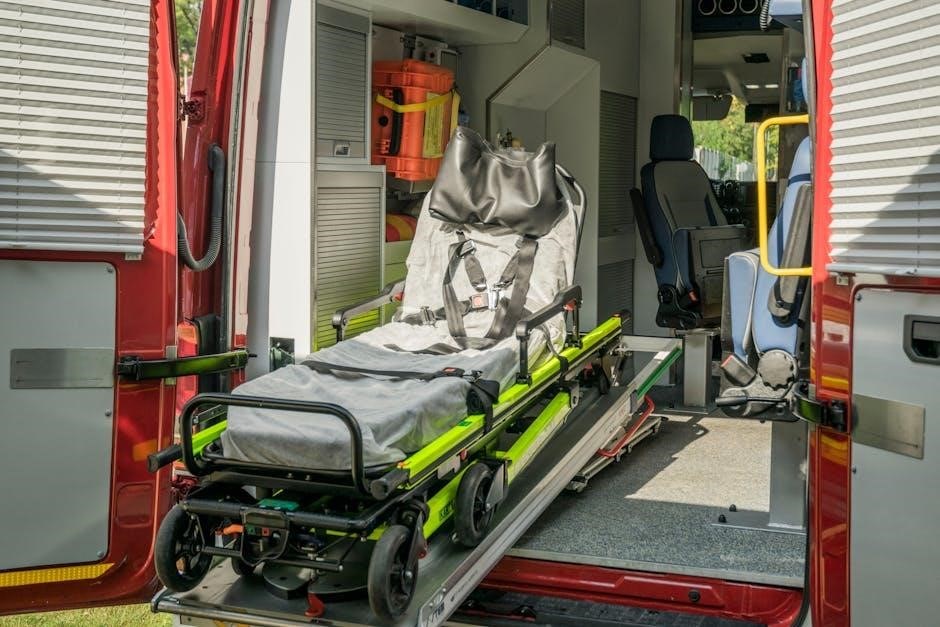First Aid Step 3 focuses on providing immediate care to stabilize the victim until professional help arrives, emphasizing safety, assessment, and essential interventions to prevent further harm.
Definition and Importance of First Aid Step 3
First Aid Step 3, also known as the Care phase, involves providing immediate and temporary assistance to stabilize the victim until professional medical help arrives. This step is critical in preventing further harm, reducing the risk of complications, and promoting recovery. It focuses on interventions such as controlling bleeding, managing wounds, administering CPR, and treating burns or fractures. The importance of Step 3 lies in its ability to bridge the gap between the initial assessment and professional medical care, ensuring the victim’s condition does not deteriorate. Proper execution of this step requires knowledge of basic first aid techniques and the confidence to act decisively. By prioritizing the victim’s safety and well-being, First Aid Step 3 plays a vital role in saving lives and improving outcomes in emergency situations.
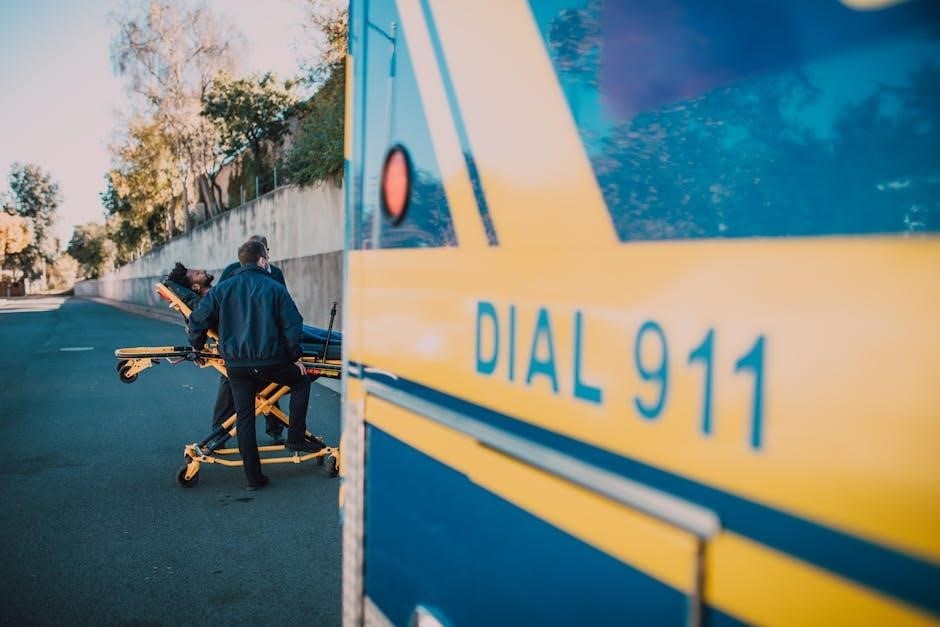
Overview of the Three Cs of First Aid
The Three Cs of First Aid—Check, Call, and Care—provide a structured approach to responding effectively in emergencies. The Check step involves assessing the scene for safety and evaluating the victim’s condition to identify immediate threats. Call requires securing emergency assistance by contacting local emergency services and providing accurate information. Finally, Care entails administering appropriate first aid interventions to stabilize the victim until professional help arrives. These steps ensure a logical progression from safety assessment to immediate action, addressing both physical and psychological needs. The Three Cs are universally applicable, making them an essential framework for first responders and bystanders alike. By following this sequence, individuals can provide timely and effective care, significantly improving outcomes in critical situations. This approach emphasizes preparedness and confident action, fostering a proactive response to emergencies.
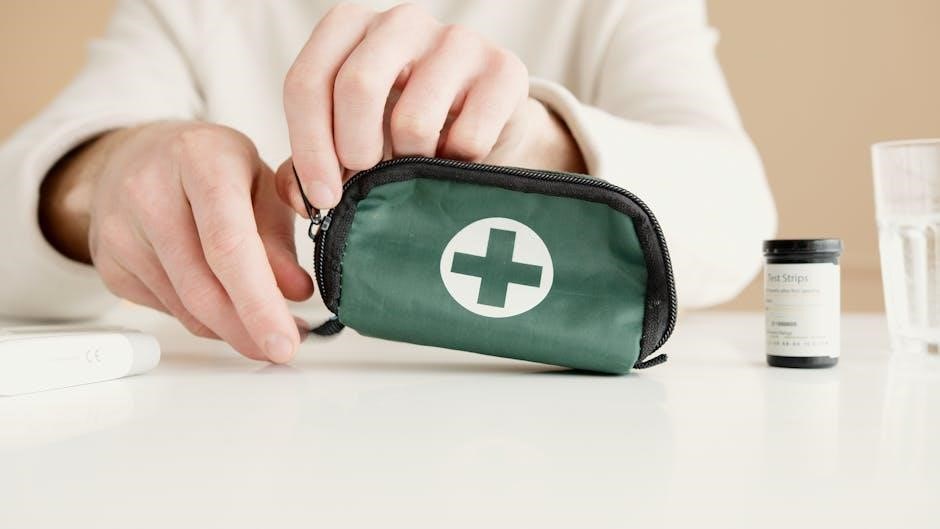
The Three Cs of First Aid
The Three Cs—Check, Call, and Care—are fundamental principles guiding first aid response, ensuring safety, seeking help, and providing immediate assistance to stabilize victims until professional medical aid arrives.
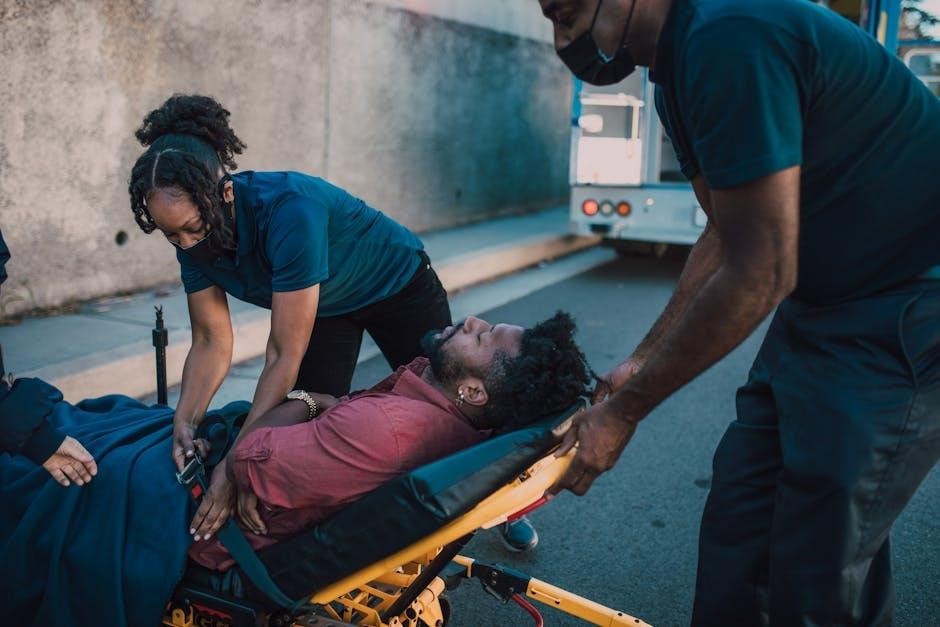
Check: Ensuring Safety and Assessing the Situation
The first C, Check, is crucial for ensuring both the responder’s and the victim’s safety. Begin by evaluating the environment for potential hazards, such as traffic, fire, or falling objects, to avoid putting yourself at risk. Once the scene is deemed safe, approach the victim cautiously. Assess the victim’s responsiveness by speaking loudly, tapping gently, or asking if they are okay. Check for breathing and pulse if the victim is unresponsive. Perform a head-to-toe survey to identify visible injuries, bleeding, or deformities. This step ensures a clear understanding of the situation, allowing for appropriate care. Always prioritize safety and avoid moving the victim unnecessarily unless immediate danger exists. This initial assessment guides the next steps in providing effective first aid. Proper execution of the Check step ensures a systematic and safe approach to helping the injured or ill person.
Call: Seeking Emergency Assistance
The second C, Call, involves securing emergency help promptly. After ensuring the scene is safe and assessing the victim’s condition, dial the local emergency number, such as 911, or instruct someone else to do so. Provide clear, concise information about the situation, including the location, number of victims, and the nature of the injury or illness. If the victim is unresponsive and not breathing, request guidance on performing CPR. Stay on the line until the operator confirms all necessary details. If alone with an unresponsive victim, call for help before starting care. This step ensures professional medical assistance is on the way, maximizing the chances of a positive outcome. Timely communication is critical in emergencies, making the Call step a vital link to advanced care.
Care: Providing Immediate Assistance
The third C, Care, involves providing immediate, temporary assistance to stabilize the victim until professional help arrives. This step requires practical skills to address specific injuries or illnesses. If the victim is unresponsive and not breathing, initiate CPR if trained to do so. For bleeding, apply direct pressure using a clean cloth or bandage. In cases of burns, cool the affected area with cool water, and for fractures, immobilize the injured limb. Assess the victim’s airway, breathing, and circulation (ABCs) and monitor their condition closely. Provide comfort and reassurance to keep the victim calm. Avoid moving the victim unless necessary for safety. The goal of Care is to prevent further harm and maintain the victim’s condition until medical professionals take over. Proper training is essential to deliver effective care confidently and correctly in emergencies.

First Aid Step 3: Care
Providing immediate care involves administering essential first aid to stabilize the victim’s condition until professional help arrives, focusing on interventions like CPR, wound management, and injury immobilization.
Understanding the Purpose of Care in First Aid
The purpose of care in first aid is to provide immediate, temporary assistance to stabilize the victim’s condition until professional medical help arrives. It focuses on preserving life, preventing further injury or deterioration, and promoting recovery. Proper care involves assessing the situation, identifying the injury or illness, and applying appropriate interventions. The primary goal is to ensure the victim’s airway, breathing, and circulation (ABCs) are maintained, and to address specific needs such as wound management, immobilization, or cardiopulmonary resuscitation (CPR). Effective care requires a calm and confident approach, adherence to first aid principles, and the use of available resources. By following the three Cs—Check, Call, and Care—first responders can make a critical difference in emergency situations. Proper training and knowledge are essential to deliver care that is both safe and effective.
Key Principles of Providing Care
Providing care in first aid involves several key principles to ensure effective and safe assistance. First, always prioritize the victim’s airway, breathing, and circulation (ABCs) to maintain vital functions. next, control bleeding by applying direct pressure and elevating the injured limb if possible. Use protective equipment like gloves to prevent exposure to bodily fluids. Assess the victim’s responsiveness and check for breathing or pulse to determine if CPR is needed. Provide psychological support by reassuring the victim and keeping them calm. Avoid moving the victim unnecessarily unless there is immediate danger. Use first aid kits and equipment appropriately, such as bandages for wounds or splints for fractures. Follow established first aid guidelines and seek professional medical help as soon as possible. These principles ensure care is administered safely and effectively, maximizing the chances of a positive outcome.
Common Scenarios Requiring Immediate Care
Several common scenarios require immediate care, including cardiac arrest, severe injuries, burns, and fractures. Cardiac arrest demands prompt CPR to maintain blood circulation. Severe bleeding must be controlled with direct pressure and elevation. Burns need cooling to reduce tissue damage, while fractures require stabilization to prevent further injury. Choking incidents necessitate back slaps or abdominal thrusts. In all cases, ensuring the victim’s airway, breathing, and circulation (ABCs) is critical. Immediate care also applies to unconsciousness, head injuries, or severe allergic reactions. Each scenario requires specific interventions to stabilize the victim until professional help arrives. Recognizing these situations and acting swiftly can significantly improve outcomes. Proper training in first aid techniques is essential to handle such emergencies effectively and confidently. These scenarios highlight the importance of timely and appropriate care in life-threatening situations.

Practical Applications of First Aid Step 3
CPR, wound management, burns, fractures, and bleeding control are critical applications of First Aid Step 3. These interventions often save lives by stabilizing victims until professional help arrives.
Cardiopulmonary Resuscitation (CPR)
CPR is a critical first aid technique used to restore blood circulation and breathing in a person who has stopped breathing or whose heart has stopped. It involves chest compressions and rescue breaths to maintain oxygen flow to vital organs. Proper training is essential to perform CPR effectively, as incorrect techniques can cause harm. Certification programs, such as those offered by the American Heart Association, teach the correct method of CPR, including the use of automated external defibrillators (AEDs) for cardiac arrests. CPR is most effective when administered immediately after a cardiac emergency, significantly improving survival chances. Regular recertification ensures first responders stay updated on the latest techniques. Psychological support for both the victim and responder is also emphasized, highlighting the importance of continuous learning and preparedness in life-saving situations.
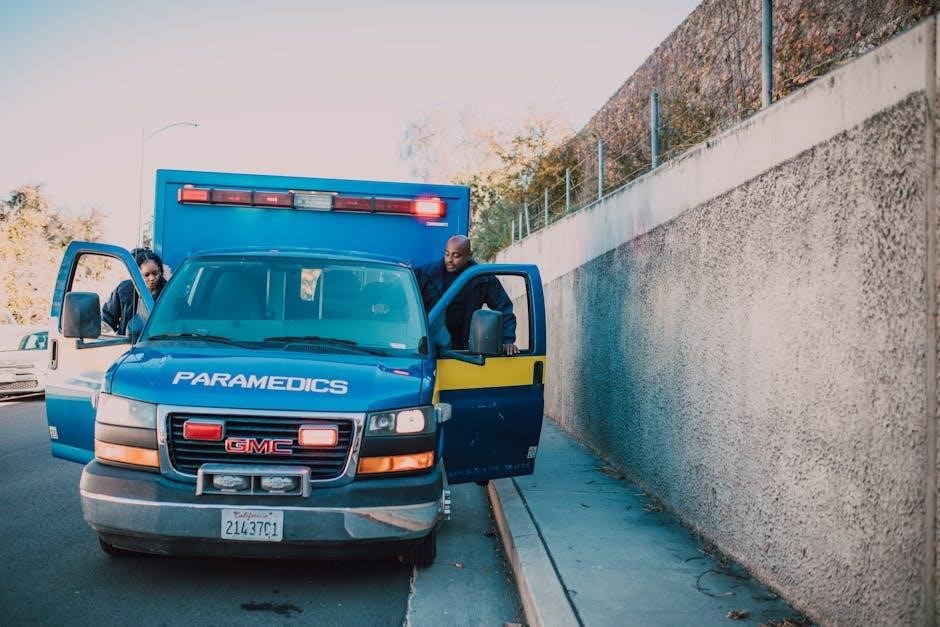
Wound Management and Bleeding Control
Effective wound management and bleeding control are vital components of first aid, aiming to prevent excessive blood loss and infection. Immediate steps include applying direct pressure to the wound using clean materials, elevating the injured limb above heart level to reduce blood flow, and using tourniquets if necessary. Proper cleaning and dressing of wounds with sterile bandages or gauze help prevent infection. Training programs emphasize recognizing different types of wounds, such as lacerations or punctures, and tailoring care accordingly. Advanced techniques may include the use of hemostatic agents to accelerate clotting. Regular updates in first aid protocols ensure responders are equipped with the latest methods to handle various scenarios effectively. These practices are crucial for maintaining victim stability until professional medical assistance arrives, underscoring the importance of comprehensive training in wound care and bleeding control techniques.
Burn Care and Management
Burn care and management are critical components of first aid, requiring immediate action to minimize tissue damage and prevent infection. The first step is to cool the burn using cool or lukewarm water for 10-15 minutes to reduce temperature and ease pain. Never use ice, as it can cause further harm. Remove any clothing or jewelry near the burn to prevent restriction. Cover the burn with a sterile, non-stick dressing or a clean cloth to protect it from contamination. Avoid applying ointments or breaking blisters, as this can lead to infection. For severe burns, call emergency services immediately. Training programs emphasize recognizing burn severity (first, second, or third degree) and providing appropriate care. Psychological support is also essential to calm the victim. Proper burn management ensures the best possible recovery outcomes while awaiting professional medical assistance. Regular updates in first aid protocols highlight the importance of effective burn care techniques.
Fracture and Sprain Management
Fracture and sprain management are essential skills in first aid, focusing on stabilizing injuries to prevent further damage. For fractures, immobilize the affected area using splints or rigid materials to avoid movement. Apply ice packs wrapped in cloth to reduce swelling and pain. Elevate the injured limb above heart level to minimize swelling. For sprains, follow the RICE method: Rest, Ice, Compression, and Elevation. Avoid moving the injured area and seek professional medical help if the injury is severe or if there’s numbness, tingling, or deformity. Proper care ensures quicker recovery and prevents long-term complications. Training programs emphasize recognizing signs of fractures and sprains, such as limited mobility or abnormal alignment. Immediate interventions like immobilization and ice application are critical. Always monitor the victim’s condition and provide emotional support until medical assistance arrives.
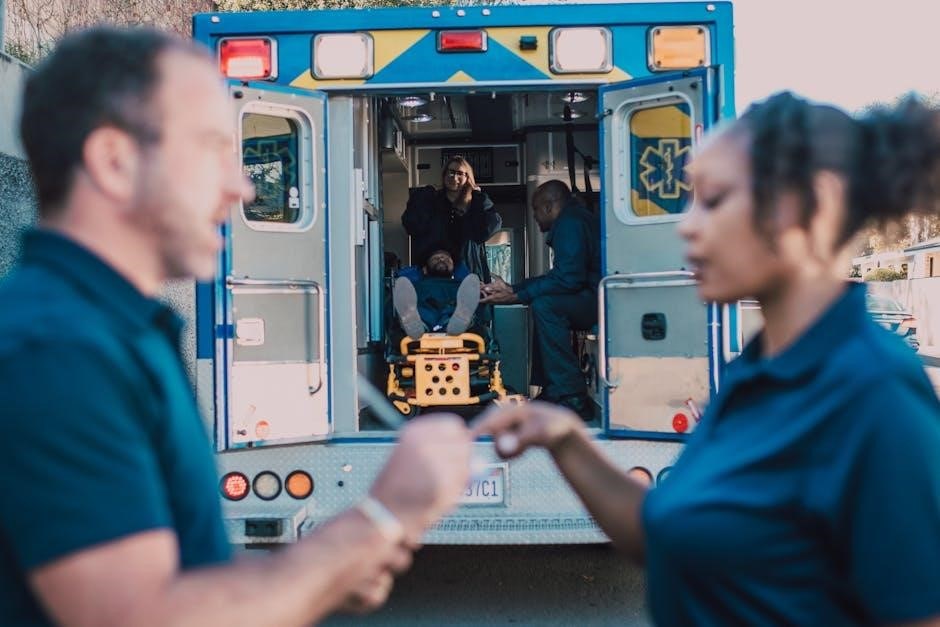
Advanced First Aid Techniques
Advanced first aid techniques build on fundamental skills, incorporating methods like CPR, AED usage, wound management, and psychological support to stabilize and care for victims effectively in emergencies.
Use of First Aid Kits and Equipment
First aid kits are essential tools in providing immediate care during emergencies. They contain supplies like bandages, antiseptics, gloves, and splints to address injuries and prevent infection.
Proper training is crucial to use these kits effectively. Knowing how to apply dressings, control bleeding, and stabilize injuries ensures that care is administered safely and correctly.
Regular inspection and restocking of first aid kits are vital to maintain their readiness. Understanding the equipment’s purpose and proper usage is key to delivering effective care in critical situations.
Administration of Medications in Emergency Situations
Administering medications in emergency situations requires proper training and caution. First responders should only provide medications they are certified to administer, such as epinephrine auto-injectors or naloxone, to prevent overdose or misuse.
Medications should never be given without clear guidance or training. Always follow the manufacturer’s instructions and ensure the victim’s condition warrants the medication’s use.
In emergencies, medications like aspirin for chest pain or insulin for diabetic emergencies may be critical, but timing and dosage must be precise. Never delay calling for professional help while administering care.
Legal and ethical considerations are vital; only trained individuals should administer medications to avoid legal repercussions. Always check expiration dates and ensure proper storage of medications in first aid kits.
Proper documentation of administered medications is essential for continuity of care when medical professionals arrive. This ensures transparency and accountability in emergency situations.
Psychological First Aid and Emotional Support
Psychological first aid (PFA) is a critical component of emergency care, focusing on emotional and mental well-being. It involves recognizing when someone may need support, actively listening, and providing reassurance to reduce stress and anxiety. PFA is not about diagnosing mental health conditions but offering a calm, empathetic presence to help individuals cope with traumatic situations.
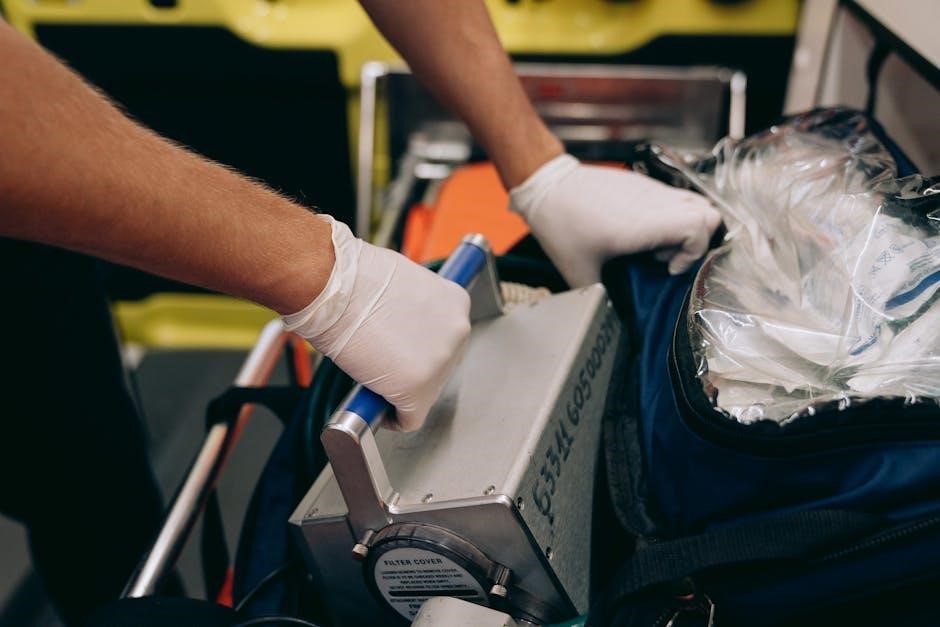
Key principles include creating a safe environment, promoting a sense of control, and connecting the person to additional support resources. It’s important to avoid forcing individuals to discuss their experiences unless they are ready. Documentation of emotional state and any interventions is essential for continuity of care;
Proper training in PFA ensures responders can address emotional distress effectively, fostering resilience and promoting recovery. Always respect the individual’s boundaries and prioritize their comfort and consent during the process.
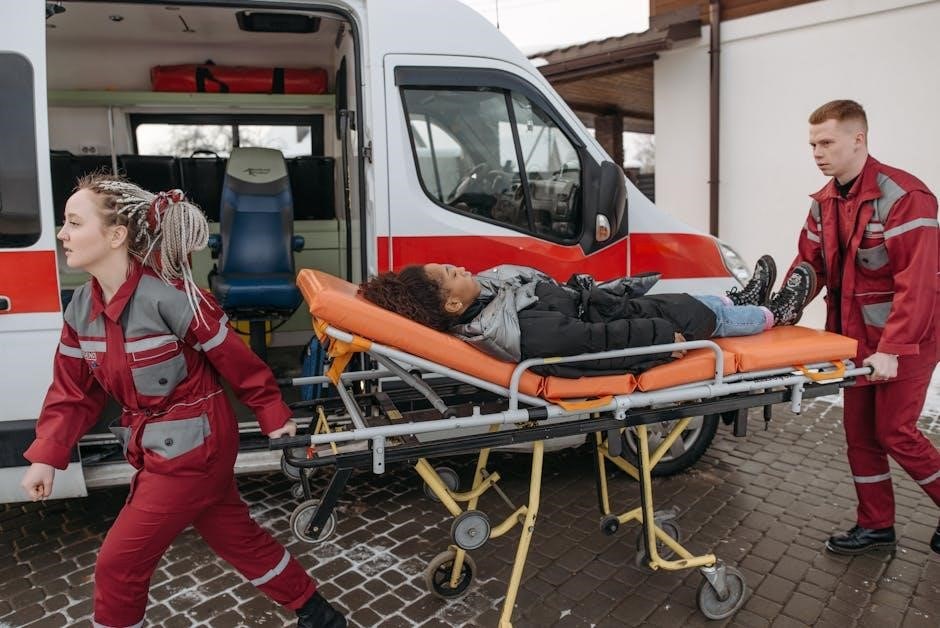
Training and Certification in First Aid
First aid training programs, like CPR and BLS certifications, teach essential skills to respond confidently in emergencies, ensuring individuals can provide effective care while adhering to safety guidelines and protocols.
Available First Aid Training Programs
Various first aid training programs are available to equip individuals with essential life-saving skills. These include CPR, BLS, and first aid certifications tailored for healthcare providers, childcare professionals, and the general public. Programs like the American Heart Association’s BLS/CPR with AED and EMSA-approved courses ensure comprehensive training. Specialized courses, such as pet first aid and babysitting safety, cater to specific needs. Online options, like HeartCode BLS, offer flexibility, combining virtual learning with in-person skills checks. Training centers in locations like San Ramon, San Jose, and Emeryville provide accessible learning opportunities. These programs vary in duration, from 2-hour refreshers to 8-hour intensive sessions, ensuring all skill levels are addressed. Certifications meet state and federal requirements, making them reliable for workplace and personal use.
- CPR with AED Training
- BLS for Healthcare Providers
- EMSA Licensed Childcare First Aid
- Pet First Aid and CPR
- Preventive Health Practices
These programs ensure participants are well-prepared to respond confidently in emergencies, providing critical care until professional help arrives.
Importance of Certification and Recertification
Importance of Certification and Recertification
Certification in first aid is crucial as it ensures individuals possess the necessary skills and knowledge to respond effectively in emergencies. Recertification maintains competency and updates practitioners on the latest techniques and guidelines. Many workplaces require first aid certification for compliance with safety regulations.Certification builds confidence and trust in one’s ability to provide care during critical situations. It also demonstrates a commitment to protecting lives and preventing further harm. Regular recertification ensures that first responders stay informed about best practices, such as updates in CPR protocols or wound management. This continuous learning is vital in a field where procedures evolve based on medical advancements. By staying certified, individuals contribute to a safer community and uphold professional standards in emergency care.
Resources for First Aid Training Materials
Access to reliable first aid training materials is essential for effective learning and application of life-saving skills. Reputable organizations like the American Heart Association (AHA) and the Red Cross provide comprehensive resources, including manuals, online courses, and video tutorials. Many training centers, such as Adams Safety Training, offer structured programs and downloadable guides to support first aid education. Additionally, websites like St. John Ambulance and the Health and Safety Executive (HSE) offer free and paid resources, ensuring accessibility for diverse learners. These materials cover topics from basic first aid to advanced techniques like CPR and wound management. Utilizing these resources helps individuals gain the confidence and knowledge needed to respond effectively in emergencies. Regular updates to these materials ensure that learners stay informed about the latest first aid protocols and best practices.
Mastering first aid step 3 empowers individuals to save lives, emphasizing the importance of immediate, effective care until professional help arrives, while encouraging ongoing skill development and community engagement.
First Aid Step 3, or the “Care” phase, involves providing immediate, temporary assistance to stabilize the victim’s condition until professional medical help arrives. This step focuses on assessing the individual’s responsiveness, monitoring vital signs, and delivering essential interventions such as CPR, wound management, or burn care. It also includes controlling bleeding, immobilizing fractures, and offering psychological support to reduce stress and anxiety. Proper training ensures that caregivers can administer these interventions safely and effectively. The goal is to prevent further harm, preserve life, and promote recovery. By following the three Cs—Check, Call, and Care—first responders can make a critical difference in emergency situations. Regular updates to first aid protocols and practices are essential to stay informed and prepared. Understanding and applying these principles can significantly improve outcomes for those in need of immediate care.
Final Thoughts on the Importance of First Aid Training
First aid training is a vital skill that empowers individuals to act confidently and effectively in emergency situations. By mastering the three Cs—Check, Call, and Care—people can provide immediate assistance, potentially saving lives and reducing suffering. Proper training ensures that caregivers can assess situations accurately, prioritize interventions, and deliver appropriate care until professional help arrives. The ability to preserve life, prevent deterioration, and promote recovery underscores the critical role of first aid in pre-hospital care. Encouraging others to learn these essential skills fosters a safer, more prepared community. Staying updated with the latest techniques and guidelines is equally important, as it ensures that first aid practices remain effective and relevant. Investing time in first aid training is a decision that can make a profound difference in critical moments.
Encouragement to Pursue Further Learning
Continuous learning in first aid is essential for building confidence and competence in emergency situations. Exploring advanced techniques, such as CPR, wound management, and psychological first aid, can significantly enhance your ability to provide effective care. Taking advantage of training programs, online resources, and certification courses ensures you stay updated with the latest guidelines and best practices. Hands-on experience with first aid kits and equipment further reinforces these skills. Encouraging others to pursue further learning fosters a community prepared to act decisively in crises. The more knowledge and skills you acquire, the greater your ability to make a positive impact. Investing time in first aid education is a commitment to saving lives and creating a safer environment for everyone.
